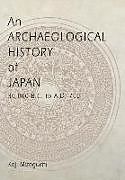An Archaeological History of Japan, 30,000 B.C. to A.D. 700
Einband:
Fester Einband
EAN:
9780812236514
Untertitel:
Englisch
Genre:
Geschichte
Autor:
Koji Mizoguchi
Herausgeber:
University Of Pennsylvania Press
Anzahl Seiten:
288
Erscheinungsdatum:
07.05.2002
ISBN:
978-0-8122-3651-4
Autorentext
Koji Mizoguchi
Klappentext
A notion widely shared among the Japanese is that a unique culture has existed uninterrupted on the archipelago since the first human settlements more than 30,000 years ago. The idea of a continuous shared Japanese culture, often described as "Japanese-ness," is epitomized by material items ranging from Zen Buddhist stone gardens and tea ceremony equipment to such archaeological artifacts as the prehistoric Jomon clay figurines. An Archaeological History of Japan challenges this notion by critically examining archaeological evidence as well as the way it has been interpreted.
By combining techniques of traditional archaeological investigation with the tools of contemporary critical sociological and anthropological theory, An Archaeological History of Japan reveals the contingent, reflexive nature of how the prehistoric inhabitants of the Japanese islands identified themselves as they mapped their social and cultural environment. Koji Mizoguchi demonstrates that this process of self-identification underwent transformations as societies and technology changed, indicating that there is no intrinsic connection binding present-day Japanese with people of the past.
Zusammenfassung
An original, substantial contribution to interpretive archaeology (the first of its kind for Japan and East Asia), An Archaeological History of Japan addresses a broad range of issues concerning the self-identification of groups and the use of the past in contemporary society.
Inhalt
List of Figures
Preface
Introduction: Self-Identification, Paradox, and the Japanese
1. What Does It Mean To Be What We Are?
-The "Japanese" in 30,000 B.P.
-Body, Mind, and Identity
-Spatio-Temporal Organization of Everyday Life
2. Archaeology and Self-Identification: The Structures of a Contemporary Japanese Topography of Identities
-Identity, Self-Identification, and the Past
-Three Period-Specific Archaeologies
-Beyond the Topography of Relativistic Cynicism
-Expectation, Self-Identification, and Material Culture
3. The Topography of Traveling and Encounters: The Paleolithic and the Initial Jomon Periods
-Climatic Conditions and the Changing Shape of the Land
-Spatio-Temporal Organization in the Late Paleolithic
-Emerging Fixity
-The Traveling Self and the Omnipresence of the Other
4. The Topography of Scheduling: The Spatio-Temporal Organization of Social Life and the Jomon-Self
-Mapping the Trajectories of Change
-The Earlier Jomon
-The Later Jomon
-Scheduling and Egalitarianism in a Complex Topography of Identities
5. The Topography of Division: Paddies, the Other and the Yayoi-Self
-The Beginning
-The Early to Early Middle Yayoi
-The Process Toward the Late Middle Yayoi Climax
-The Late Yayoi
-Emergent Division in the Topography of Identities
6. The Topography of Exclusion Through Inclusion: The Kofun-Self
-The Internalization and Glorification of the Other
-The Emergent Topography of Despotism
-The Anxiety and Solitude of Being-in-the-World
7. The Changing Topography of Identities: A Long-Term View
-The Late Paleolithic/Incipient Jomon
-The Jomon
-The Yayoi
-The Kofun
8. Conclusion: The Changing Topography of Identities, the Other, and the Nonexistence of the Essence of Identity
References
Index
Acknowledgments

Leider konnten wir für diesen Artikel keine Preise ermitteln ...
billigbuch.ch sucht jetzt für Sie die besten Angebote ...
Die aktuellen Verkaufspreise von 6 Onlineshops werden in Realtime abgefragt.
Sie können das gewünschte Produkt anschliessend direkt beim Anbieter Ihrer Wahl bestellen.
Loading...
Die aktuellen Verkaufspreise von 6 Onlineshops werden in Realtime abgefragt.
Sie können das gewünschte Produkt anschliessend direkt beim Anbieter Ihrer Wahl bestellen.
| # | Onlineshop | Preis CHF | Versand CHF | Total CHF | ||
|---|---|---|---|---|---|---|
| 1 | Seller | 0.00 | 0.00 | 0.00 |
